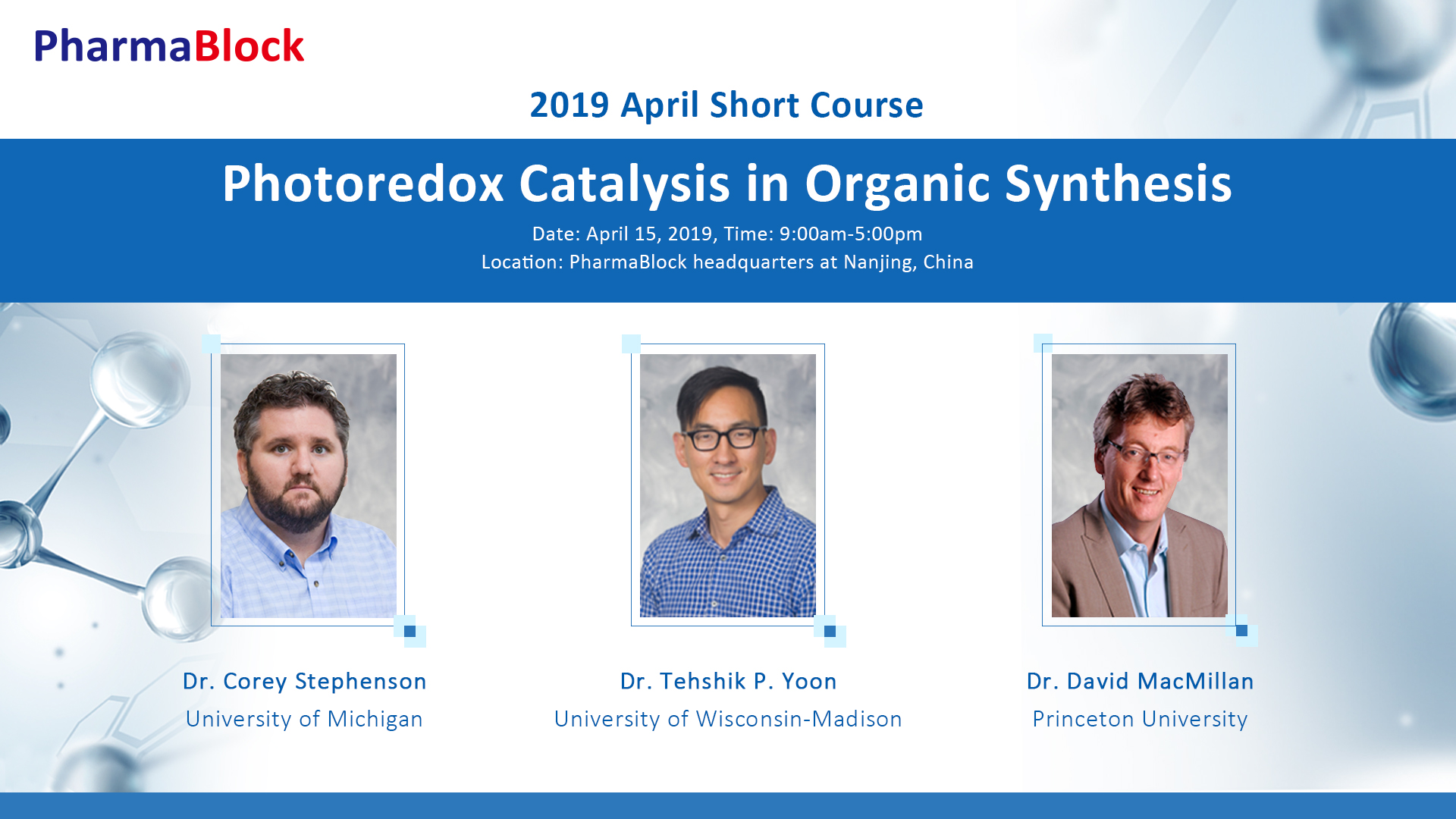
| Course Description |
Over the last decade, photoredox catalysis has become a valuable mode of activation for the invention and development of new chemical reactions of value to practitioners of medicinal and process chemistry. PharmaBlock is honored to invite the leading researchers in this area to deliver a one-day short course on photoredox catalysis, and its application to organic synthesis. Both mechanistic and practical aspects of this new catalysis area will be thoroughly discussed. |
| Instructors | ||
Professor Corey Stephenson | Professor Tehshik P. Yoon | Professor David MacMillan |
| University of Michigan | University of Wisconsin-Madison | James S. McDonnell Distinguished University Professor of Chemistry at Princeton University. |
Research area: methodologies that harness the power of visible light to mediate reactions that are useful for the synthesis of biologically active molecules. | Research area: New reaction methods for organic synthesis, especially those involving transition metal photochemistry, stereocontrolling, and dual catalysis. | Research area: asymmetric organocatalysis and its application to the synthesis of a range of complex natural products. |
Honors & Awards: Boehringer-Ingelheim New Investigator Award; Thieme Synthesis/Synlett Journal Award etc. | Honors & Awards: Beckman Young Investigator Award and National Science Foundation CAREER Award etc. | Honors & Awards: Fellow of the Royal Society, member of the American Academy of Arts and Sciences etc. |
| More about April Short Course |
| Event: 2019 April Short Course Date of Event:April 15, 2019 Time: 9:00am-5:00pm Venue:Lecture hall on the second floor, PharmaBlock headquarters, Nanjing, China |
| Specific Topics |
The physical and inorganic fundamentals of photoredox catalysis including the use of non-precious metal and organic photocatalysts. Fundamentals of free radical chemistry - a primer and examples using photoredox catalysis (we have a slide deck on this topic that we can provide butnot likely explicitly cover during the lectures). Asymmetric catalysis in photochemistry, both historical and recent results. Emphasis as desired on chiral heterocycles. New photoredox reactions of value to medicinal chemistry. Specific emphasis desired on the introduction of fluorinated groups. Reactions of alkene radical ions and triplet alkenes - why photogenerated reactive intermediates are synthetically unique. Technology in photocatalysis (flow setups for photochemical reactions, adapting known reactions to photoredox catalysis, implementing reactions in batch. A primer on studying reaction mechanisms in photochemistry, -how to measure quantum yields perform CV experiments or Stern-Volmer studies. The synergistic combination of photoredox catalysis and other types of catalysis (metal or organocatalysis). This will focus on new paradigms in crosscoupling technologies for C-C, C-O and C-N bond forming reactions including the introduction of pharmaceutically relevant functionality (as in point 4 above). Future opportunities for Photoredox Catalysis in the pharmaceutical industry. |
| Tentative Outline of Topics |
Lecture 1: Fundamental aspects of photoredox catalysis (Stephenson) Lecture 1 is largely focused on fundamentals aspects of photoredox catalysis, electrochemistry and catalyst synthesis/design. This lecture provides the background understanding necessary to successfully implement the reactions dicussed in lectures 2 through 6.
Lecture 2: Photocatalytic Activation of π-Bonds (Yoon) Lecture 2 covers reactions involving photocatalytic activation and functionalization of olefins, and includes olefin oxidation, reduction, and triplet sensitization (energy transfer catalysis), along with strategies for asymmetric catalysis.
Lecture 3: Photoredox Strategies for Medicinal and Process Chemists (MacMillan) Lecture 3 is aimed at introducing complex photoredox reaction framed in the context of problems arising in the pharmaceutical industry. Late state functionalization approaches that lend themselves to medicinal chemistryand synergistic catalysis approaches for implementation in process.
Lecture 4: Metallaphotoredox Strategies for Medicinal and Process Chemists (MacMillan) Lecture 4 includes discoveries and opportunities for the use of multiple transition metal systems in synergy with photocatalysis. Reactions with Medicinal and Process chemistry relevance are highlighted along with future opportunities for photoredox catalysis in pharma.
Lecture 5: Chain Processes in Photoredox Catalysis (Yoon) Lecture 5 outlines approaches to interrogating and understanding the operative reaction mechanisms involved in photoredox reactions. Techniques for studying the mechanism and the interpretation of the results with implications for scale up are discussed.
Lecture 6: Complex applications and practical aspects of photoredox catalysis (Stephenson) Lecture 6 focuses on the technological advances in photocatalysis, specifically in the area of reactor design/setup and continuous flow approaches to scale up. Reactions in complex pharmaceutical and natural products will be highlighted to frame the advances in technology. |

